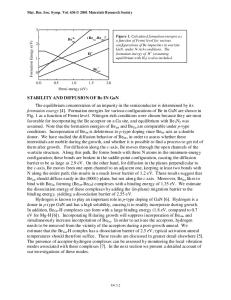Hydrogen Diffusion and Complex Formation in Silicon
- PDF / 242,480 Bytes
- 4 Pages / 420.48 x 639 pts Page_size
- 76 Downloads / 351 Views
HYDROGEN DIFFUSION AND COMPLEX FORMATION IN SILICON J.T. BORENSTEIN*,
D. TULCHINSKI** AND J.W.
*
Mobil Solar Energy Corporation, Billerica, MA 01821
**
Physics Department,
CORBETT**
4 Suburban Park Drive,
SUNY at Albany,
Albany,
NY 12222.
ABSTRACT The kinetics of hydrogen diffusion and complex formation in crystalline silicon are investigated using a model previously developed to explain the influence of dopant type and concentration on observed deuterium profiles in silicon. The predictions of the model have been shown to be in close agreement with recent SIMS profiles of deuterated FZSi crystals, with the in-diffusion process dominated by trapping at impurity sites and by the formation of immobile hydrogen molecules. Previous studies have treated the surface concentration of hydrogen and the capture radii of hydrogen at complexes as free kinetic parameters. We present an analytic relationship between the diffusion coefficient D of neutral hydrogen and both the hydrogen surface concentration and the capture radius for molecule formation. The consequences of fixing D at the known high-temperature value for the diffusion coefficient in the model are determined. The existence of this analytic relation reduces the number of free parameters in the kinetic model and leads to an improved understanding of hydrogen reactions in silicon.
INTRODUCTION The interaction of hydrogen with crystalline silicon has attracted considerable interest over the last several years, both from a fundamental standpoint and because of important technological applications. Despite its small size and simple atomic structure, hydrogen is associated with a wide array of complex phenomena in the silicon lattice, including passivation of deep levels, dopant deactivation, and structural changes [1]. Several theoretical calculations [2-4] have resulted in important predictions regarding the state and motion of hydrogen in the silicon lattice. Several of these calculations have obtained close agreement with the early high-temperature diffusion measurements of van Wierengen and Warmoltz (VWW) [5], providing evidence that unencumbered hydrogen diffusion does in fact proceed at the rapid VVW rate. Recent kinetic models [6-10] have been proposed in order to explain observed low-temperature H passivation data, including the strong differences between H profiles in n- and p-type silicon. These models have attempted to describe various effects, including hydrogen molecule formation, hydrogen-dopant trapping and charge-state effects, electric
field drift of charged species, and thermal dissociation of the hydrogen complexes. In order to account for all of these effects, the models typically contain a large number of free parameters, and the results and conclusions differ widely. The large number of parameters, as well as the multitude of best-fit models capable of describing the process, preclude the opportunity for new physical insight. In the present work we have attempted to explain observed hydrogen diffusion profiles with a simplified model,
Data Loading...
